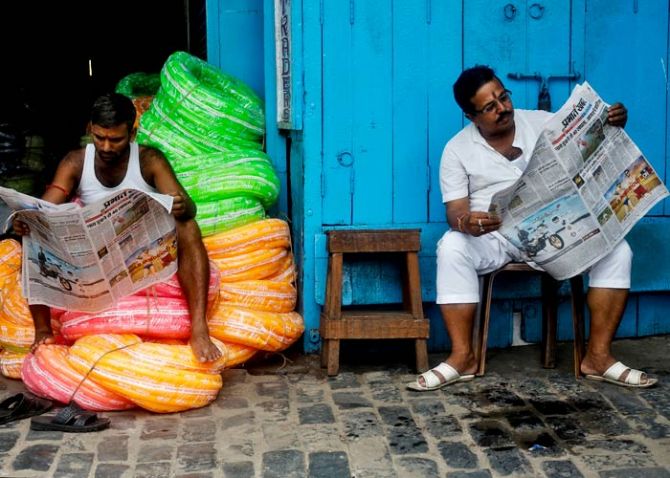From 42 million in 2011, there are now 234 million Indians using the internet in local languages, finds Vanita Kohli-Khandekar.

Photograph: Rupak De Chowdhuri/Reuters.
The action in Indian-language news websites has been relentless.
Last month, the BBC launched news sites in Telugu, Marathi, Gujarati and Punjabi.
In September, The Wire, an English news website, started its Urdu edition. It came on the heels of its Hindi version.
In August, Google launched voice search in eight Indian languages, including Urdu, Malayalam and Tamil. It already has voice search in Hindi and English.
"Two years ago, we at Google realised that if we don't adopt Indian languages, we would be out of business," said Rahul Kapoor, head of strategic partnerships, Google India, at Digipub, a digital publishing event, recently.
"There has been a meteoric rise in Indian language consumption online in the last 1-1.5 years," said Nikhil Pahwa, founder and editor, Medianama.
From 42 million in 2011, there are 234 million Indians using the internet in local languages. That is just over half of India's 409 million internet users in 2016, according to a study done by KPMG and Google.
By 2021, the number of Indians using the internet in local languages will reach 536 million or about 72 per cent of Indians online.
Of these, those going online to read/consume news in local languages will rise from 106 million in 2016 to 284 million by 2021, about 85 million more than for English.
This essentially means Tamil, Telugu, Gujarati, Hindi and Urdu will be among the 10 key languages driving traffic and consumption of online news in India's ₹7,690-crore digital media market.
Why Tamil, Telugu or Urdu?
The reasons are easy to see. Take the ₹700-crore Sakal Media Group that publishes the eponymous Marathi newspaper, and has a presence in TV and digital. Of its five sites, flagship eSakal has seen a three times jump in traffic -- 1.5 million monthly users -- in just a year.
"What worked for us was social media, especially Facebook. We have 1.1 million regular users on Facebook," says CEO, Pradeep Dwivedi.
On Twitter, Sakal has different handles for different editions.
Through its database of readers, it pushes 8-10 news stories of the day to 2,000 WhatsApp groups.
Roughly half of eSakal's traffic comes via social media.
"The growth of social media has made it easier to discover Indian language content," reckons Pahwa. This corresponds to the boom in smartphone devices and data prices falling by a massive 96 per cent in the last one year alone, says the KPMG-Google report.
The bigger changes propelling this growth are within the media ecosystem itself.
From being able to find Indian language content online to fonts configured for Hindi, Tamil or Telugu to IT talent that understands language markets, the last couple of years have seen huge strides being taken on all fronts.
Typically, a language publication or news channel has an audience size 10-30 times bigger than that for English.
Kannada, Tamil and Hindi newspapers are among the fastest growing in circulation and readership. Not surprisingly, then, these three languages also have the highest internet adoption levels among all language users.
"They consume news, entertainment, personal finance, stocks. People in small towns are discovering technology, they read a lot of product reviews," says B G Mahesh, founder and managing director, OneIndia.com, which offers news in seven Indian languages.
Google's Kapoor points to Sharmaji Technical, a YouTube channel launched by Praval Sharma a couple of years back. It reviews tech products, largely mobile phones and laptops in Hindi. Sharmaji Technical has over 644,000 subscribers faithfully logging in and commenting.
"The propensity to consume content is higher in languages and an ecosystem of content creators exists. The challenge is how do revenues follow," said Anoop N, COO (digital), Asianet, which offers news online in all the four South Indian languages, at Digipub.
The tricky parts
Though English still gets 2-2.5 times better CPMs (cost per mille or thousand) than Indian languages, the gap has narrowed. The tricky part is nudging advertisers and publishers towards changes that could mean better rates.
Gyan Gupta, CEO, Dainik Bhaskar, points to one. "Why do we have an English ad on a Hindi news site? A Hindi creative on a Hindi site gives four times better performance," he said at an industry event last month.
The KPMG-Google report seconds that: 88 per cent of Indian language internet users are more likely to respond to a digital advertisement in their local language than in English.
The other thing that could get better rates is sticking to what the brand stands for and doing direct deals with advertisers, says Dwivedi of Sakal.
Gupta adds a third variable, "Once you move to programmatic, language differentiation goes."
Programmatic means selling ad space through an automated network that places ads based on traffic and other objective variables, and since Indian language sites do much better on volumes, they stand to gain with its use.
Rajiv Dhingra, founder and CEO, WATConsult, a digital agency, agrees there is some uptick, but doesn't see language content becoming a dominant part of ad spends: "We handle ₹250-300 crore worth of budgets and at best 10-15 per cent goes to Indian language content. CPMs in Indian languages can sometimes be more than for English. For example, Malayala Manorama has a larger share of premium audience than English language publications. But largely CPM is very deal and market specific."
He reckons the share of Indian languages of the ad spend could grow to 20-25 per cent, led largely by video: "Textual content is never going to be as big as English unless very good regional content players come and disrupt."
Dwivedi agrees: "In 5-7 years, I don't think any amount of digital revenue will offset the loss from print unless we monetise our audience through pay or make the site commerce-enabled."
For vernacular news websites, the high from the rise in traffic could wear off soon if revenues don't follow.












